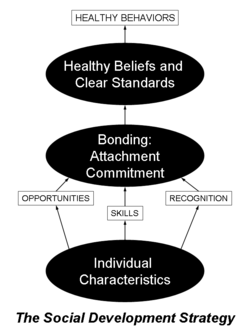This article is written like a personal reflection, personal essay, or argumentative essay that states a Wikipedia editor's personal feelings or presents an original argument about a topic. (August 2009) |
Communities That Care (CTC)[1] is a program of the Center for Substance Abuse Prevention (CSAP) in the office of the United States Government's Substance Abuse and Mental Health Services Administration (SAMHSA). CTC is a coalition-based prevention operating system that uses a public health approach to prevent youth problem behaviors such as violence, delinquency, school drop out and substance abuse.[2] Using strategic consultation, training, and research-based tools, CTC is designed to help community stakeholders and decision makers understand and apply information about risk and protective factors, and programs that are proven to make a difference in promoting healthy youth development, in order to most effectively address the specific issues facing their community's youth.[3][4]

Developed by Drs. J. David Hawkins and Richard Catalano at the University of Washington's Social Development Research Group (SDRG), CTC's principal strategy, the Social Development Strategy (right), focuses on strengthening protective factors that can buffer young people from problem behaviors and promote positive youth development.[5]
CTC is grounded in rigorous research from social work, public health, psychology, education, medicine, criminology, and organizational development. It engages all community members who have a stake in healthy futures for young people and sets priorities for action based on community challenges and strengths. Clear, measurable outcomes are tracked over time to show progress and ensure accountability.[6]
- ^ Rhew, I.C.; Brown, E.C.; Hawkins, J.D.; Briney, J.S. "Sustained effects of Communities That Care on prevention service system transformation". Under Review.
- ^ Hawkins JD, Catalano RF, & Associates. 1992. Communities That Care: Action for drug abuse prevention. San Francisco: Jossey-Bass, Inc.
- ^ Fagan, A.A., Hawkins, J.D., Catalano, R.F. (2008). Using community epidemiologic data to improve social settings: The Communities That Care prevention system. In M. Shin (Ed.) Toward positive youth development: Transforming schools and community programs (pp. 292–312). Oxford; New York: Oxford University Press.
- ^ "Welcome to Communities That Care". Archived from the original on 2010-05-27. Retrieved 2008-12-18.
- ^ Hawkins, J. D.; Weis, J. G. (1985). "The social development model: An integrated approach to delinquency prevention". Journal of Primary Prevention. 6 (2): 73–97. doi:10.1007/BF01325432. PMID 24271382. S2CID 7826573.
- ^ Hawkins, J. D.; Catalano, R. F.; Arthur, M. W. (2002). "Promoting science-based prevention in communities". Addictive Behaviors. 27 (6): 951–976. doi:10.1016/S0306-4603(02)00298-8. PMID 12369478.